ACCT 101: Finance Assignment on Bank Reconciliation and Depreciation
VerifiedAdded on 2020/05/11
|6
|1144
|97
Homework Assignment
AI Summary
This document presents solutions to an ACCT 101 accounting assignment. The first question explains the importance of a bank reconciliation statement, detailing its role in ensuring accuracy and detecting errors, with real-world examples of discrepancies between cashbook and bank statement balances. The second question delves into accounting for uncollectible accounts receivable, contrasting the direct write-off method with the allowance method, and providing examples to illustrate their application. The third question defines depreciation and outlines various depreciation methods, including straight-line, reducing balance, sum of the years' digits, and units of activity, accompanied by numerical examples for each method to clarify their calculation and impact on asset valuation. The assignment covers key concepts in financial accounting, including bank reconciliation, depreciation, and the treatment of uncollectible accounts receivable.
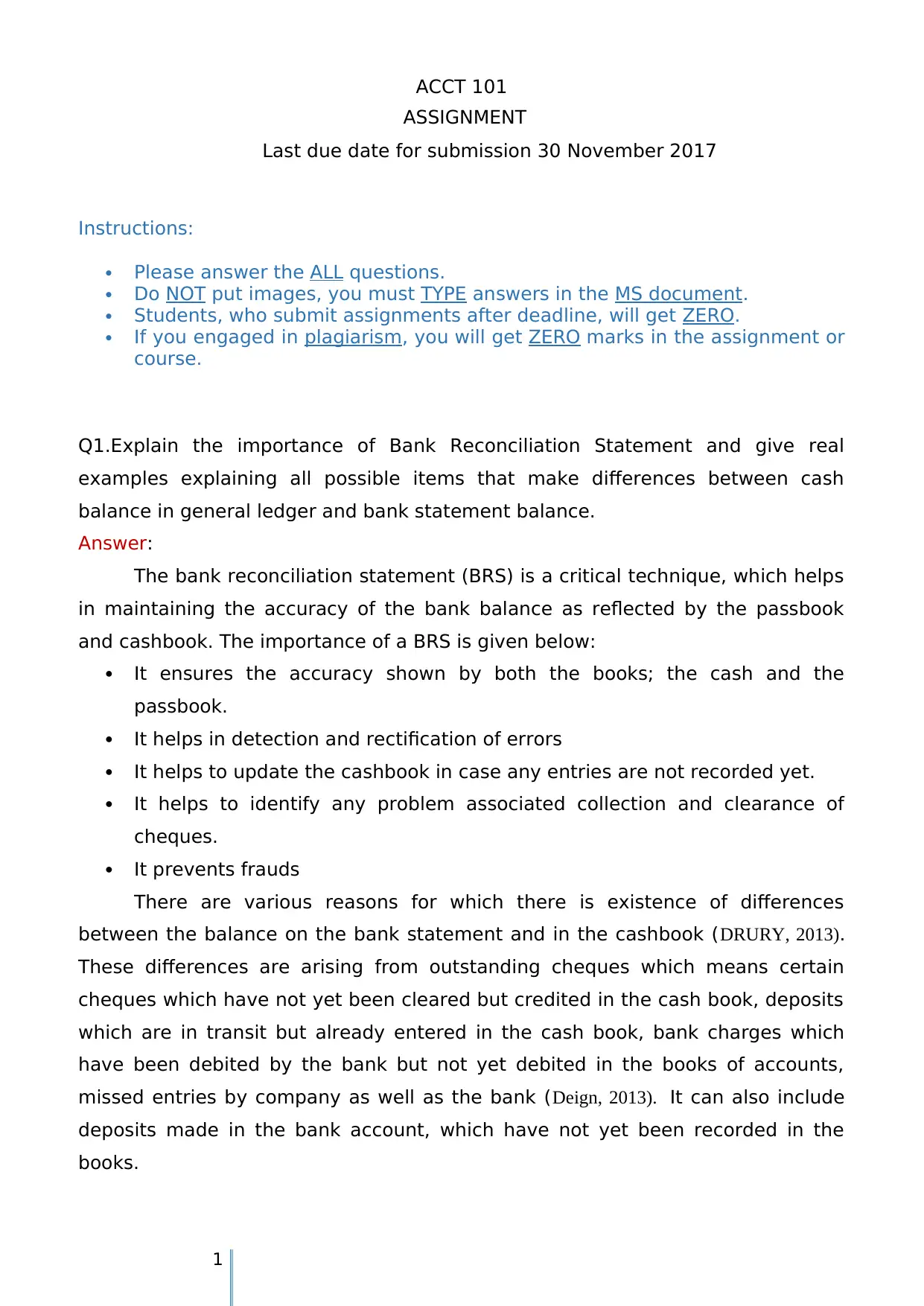
ACCT 101
ASSIGNMENT
Last due date for submission 30 November 2017
Instructions:
Please answer the ALL questions.
Do NOT put images, you must TYPE answers in the MS document.
Students, who submit assignments after deadline, will get ZERO.
If you engaged in plagiarism, you will get ZERO marks in the assignment or
course.
Q1.Explain the importance of Bank Reconciliation Statement and give real
examples explaining all possible items that make differences between cash
balance in general ledger and bank statement balance.
Answer:
The bank reconciliation statement (BRS) is a critical technique, which helps
in maintaining the accuracy of the bank balance as reflected by the passbook
and cashbook. The importance of a BRS is given below:
It ensures the accuracy shown by both the books; the cash and the
passbook.
It helps in detection and rectification of errors
It helps to update the cashbook in case any entries are not recorded yet.
It helps to identify any problem associated collection and clearance of
cheques.
It prevents frauds
There are various reasons for which there is existence of differences
between the balance on the bank statement and in the cashbook (DRURY, 2013).
These differences are arising from outstanding cheques which means certain
cheques which have not yet been cleared but credited in the cash book, deposits
which are in transit but already entered in the cash book, bank charges which
have been debited by the bank but not yet debited in the books of accounts,
missed entries by company as well as the bank (Deign, 2013). It can also include
deposits made in the bank account, which have not yet been recorded in the
books.
1
ASSIGNMENT
Last due date for submission 30 November 2017
Instructions:
Please answer the ALL questions.
Do NOT put images, you must TYPE answers in the MS document.
Students, who submit assignments after deadline, will get ZERO.
If you engaged in plagiarism, you will get ZERO marks in the assignment or
course.
Q1.Explain the importance of Bank Reconciliation Statement and give real
examples explaining all possible items that make differences between cash
balance in general ledger and bank statement balance.
Answer:
The bank reconciliation statement (BRS) is a critical technique, which helps
in maintaining the accuracy of the bank balance as reflected by the passbook
and cashbook. The importance of a BRS is given below:
It ensures the accuracy shown by both the books; the cash and the
passbook.
It helps in detection and rectification of errors
It helps to update the cashbook in case any entries are not recorded yet.
It helps to identify any problem associated collection and clearance of
cheques.
It prevents frauds
There are various reasons for which there is existence of differences
between the balance on the bank statement and in the cashbook (DRURY, 2013).
These differences are arising from outstanding cheques which means certain
cheques which have not yet been cleared but credited in the cash book, deposits
which are in transit but already entered in the cash book, bank charges which
have been debited by the bank but not yet debited in the books of accounts,
missed entries by company as well as the bank (Deign, 2013). It can also include
deposits made in the bank account, which have not yet been recorded in the
books.
1
Paraphrase This Document
Need a fresh take? Get an instant paraphrase of this document with our AI Paraphraser
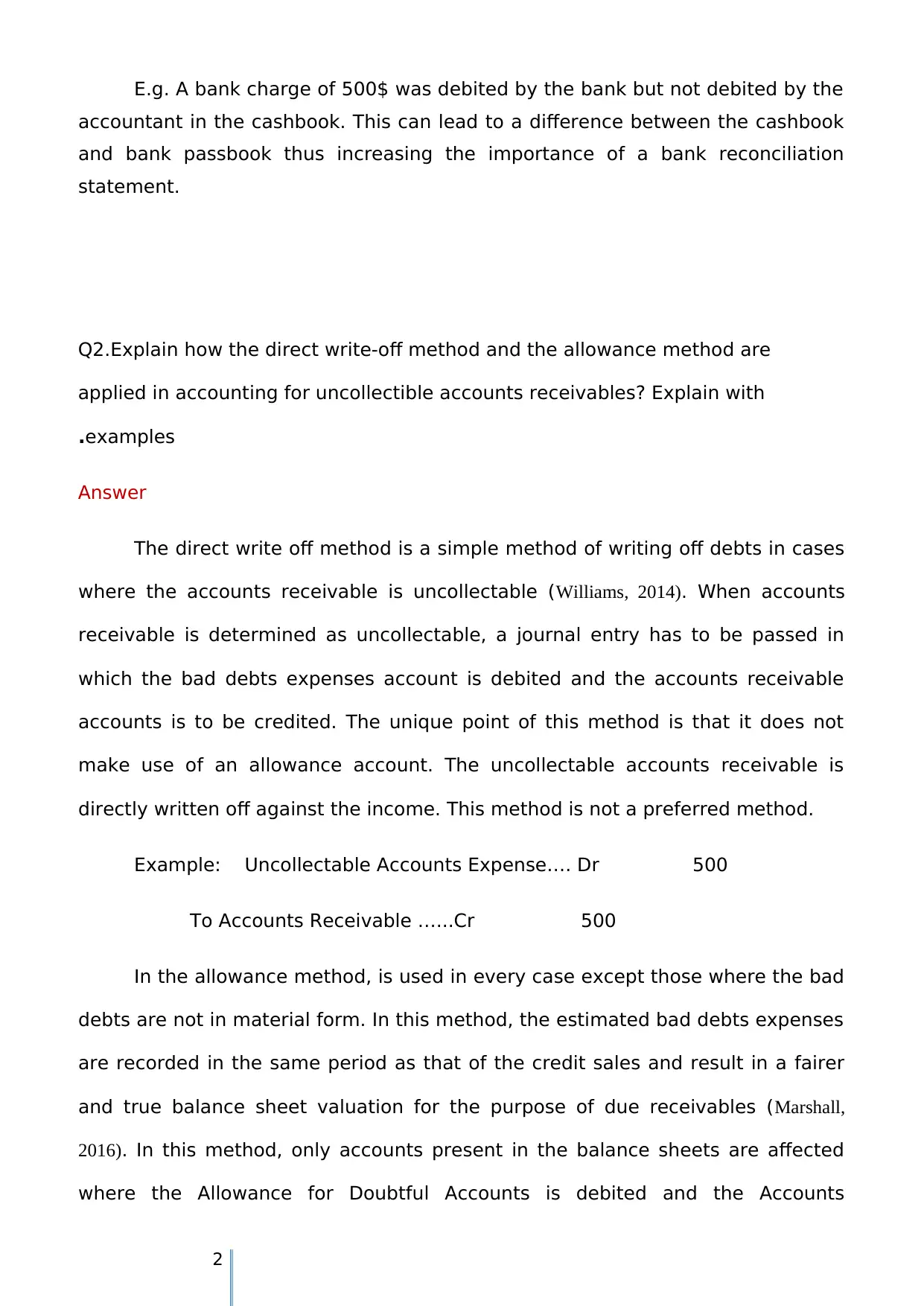
E.g. A bank charge of 500$ was debited by the bank but not debited by the
accountant in the cashbook. This can lead to a difference between the cashbook
and bank passbook thus increasing the importance of a bank reconciliation
statement.
Q2.Explain how the direct write-off method and the allowance method are
applied in accounting for uncollectible accounts receivables? Explain with
examples.
Answer
The direct write off method is a simple method of writing off debts in cases
where the accounts receivable is uncollectable (Williams, 2014). When accounts
receivable is determined as uncollectable, a journal entry has to be passed in
which the bad debts expenses account is debited and the accounts receivable
accounts is to be credited. The unique point of this method is that it does not
make use of an allowance account. The uncollectable accounts receivable is
directly written off against the income. This method is not a preferred method.
Example: Uncollectable Accounts Expense…. Dr 500
To Accounts Receivable …...Cr 500
In the allowance method, is used in every case except those where the bad
debts are not in material form. In this method, the estimated bad debts expenses
are recorded in the same period as that of the credit sales and result in a fairer
and true balance sheet valuation for the purpose of due receivables (Marshall,
2016). In this method, only accounts present in the balance sheets are affected
where the Allowance for Doubtful Accounts is debited and the Accounts
2
accountant in the cashbook. This can lead to a difference between the cashbook
and bank passbook thus increasing the importance of a bank reconciliation
statement.
Q2.Explain how the direct write-off method and the allowance method are
applied in accounting for uncollectible accounts receivables? Explain with
examples.
Answer
The direct write off method is a simple method of writing off debts in cases
where the accounts receivable is uncollectable (Williams, 2014). When accounts
receivable is determined as uncollectable, a journal entry has to be passed in
which the bad debts expenses account is debited and the accounts receivable
accounts is to be credited. The unique point of this method is that it does not
make use of an allowance account. The uncollectable accounts receivable is
directly written off against the income. This method is not a preferred method.
Example: Uncollectable Accounts Expense…. Dr 500
To Accounts Receivable …...Cr 500
In the allowance method, is used in every case except those where the bad
debts are not in material form. In this method, the estimated bad debts expenses
are recorded in the same period as that of the credit sales and result in a fairer
and true balance sheet valuation for the purpose of due receivables (Marshall,
2016). In this method, only accounts present in the balance sheets are affected
where the Allowance for Doubtful Accounts is debited and the Accounts
2
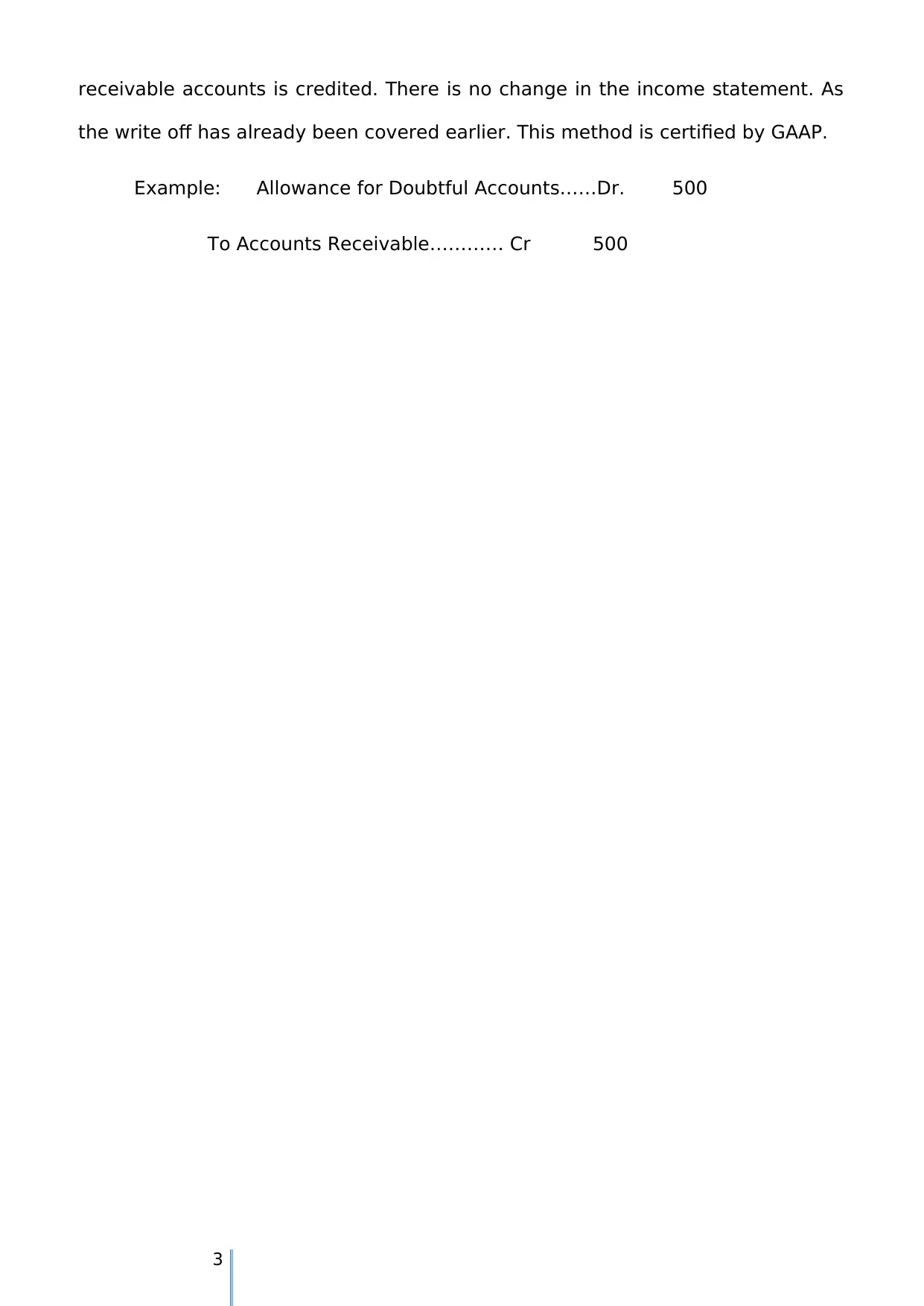
receivable accounts is credited. There is no change in the income statement. As
the write off has already been covered earlier. This method is certified by GAAP.
Example: Allowance for Doubtful Accounts……Dr. 500
To Accounts Receivable………… Cr 500
3
the write off has already been covered earlier. This method is certified by GAAP.
Example: Allowance for Doubtful Accounts……Dr. 500
To Accounts Receivable………… Cr 500
3
⊘ This is a preview!⊘
Do you want full access?
Subscribe today to unlock all pages.

Trusted by 1+ million students worldwide
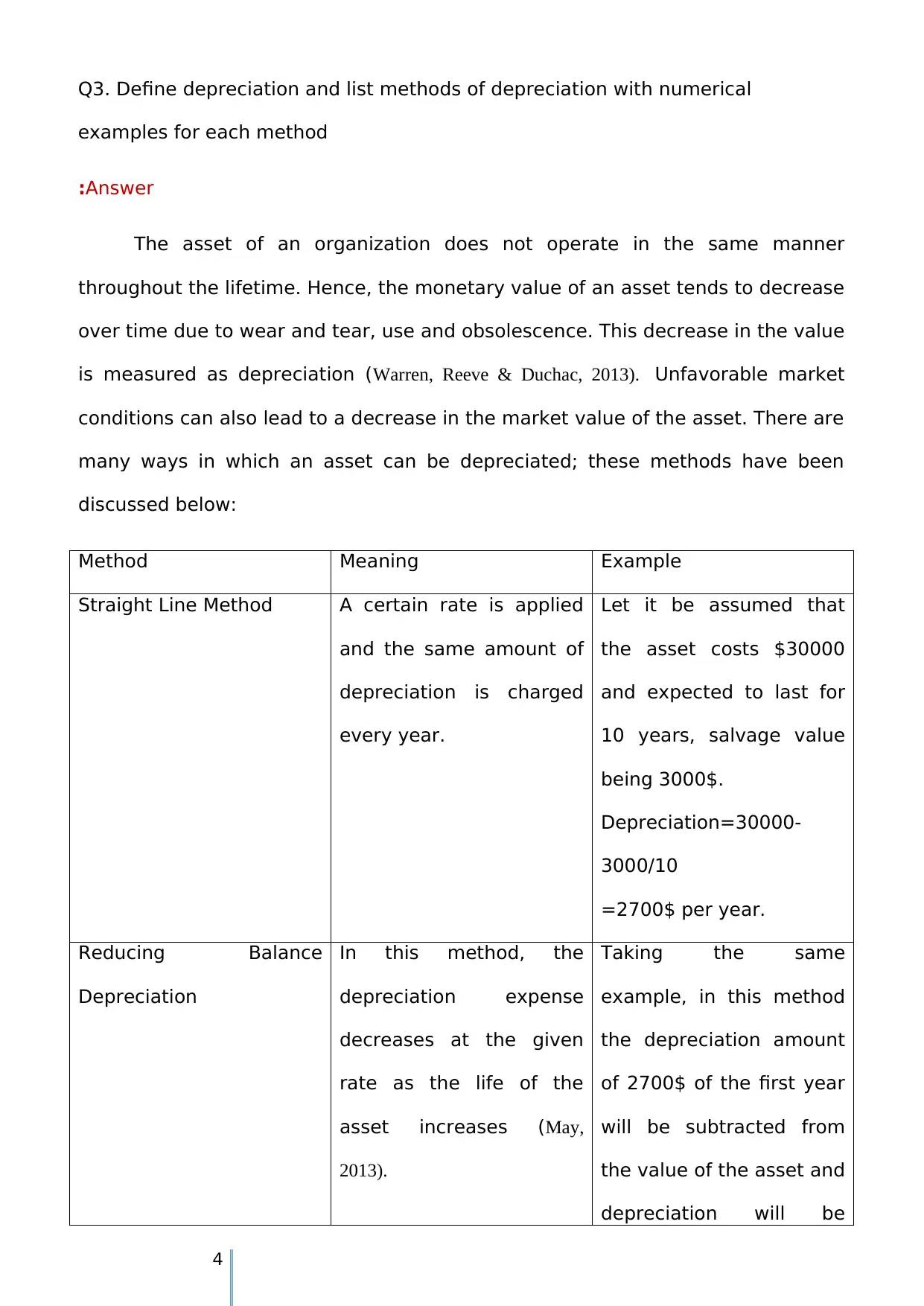
Q3. Define depreciation and list methods of depreciation with numerical
examples for each method
Answer:
The asset of an organization does not operate in the same manner
throughout the lifetime. Hence, the monetary value of an asset tends to decrease
over time due to wear and tear, use and obsolescence. This decrease in the value
is measured as depreciation (Warren, Reeve & Duchac, 2013). Unfavorable market
conditions can also lead to a decrease in the market value of the asset. There are
many ways in which an asset can be depreciated; these methods have been
discussed below:
Method Meaning Example
Straight Line Method A certain rate is applied
and the same amount of
depreciation is charged
every year.
Let it be assumed that
the asset costs $30000
and expected to last for
10 years, salvage value
being 3000$.
Depreciation=30000-
3000/10
=2700$ per year.
Reducing Balance
Depreciation
In this method, the
depreciation expense
decreases at the given
rate as the life of the
asset increases (May,
2013).
Taking the same
example, in this method
the depreciation amount
of 2700$ of the first year
will be subtracted from
the value of the asset and
depreciation will be
4
examples for each method
Answer:
The asset of an organization does not operate in the same manner
throughout the lifetime. Hence, the monetary value of an asset tends to decrease
over time due to wear and tear, use and obsolescence. This decrease in the value
is measured as depreciation (Warren, Reeve & Duchac, 2013). Unfavorable market
conditions can also lead to a decrease in the market value of the asset. There are
many ways in which an asset can be depreciated; these methods have been
discussed below:
Method Meaning Example
Straight Line Method A certain rate is applied
and the same amount of
depreciation is charged
every year.
Let it be assumed that
the asset costs $30000
and expected to last for
10 years, salvage value
being 3000$.
Depreciation=30000-
3000/10
=2700$ per year.
Reducing Balance
Depreciation
In this method, the
depreciation expense
decreases at the given
rate as the life of the
asset increases (May,
2013).
Taking the same
example, in this method
the depreciation amount
of 2700$ of the first year
will be subtracted from
the value of the asset and
depreciation will be
4
Paraphrase This Document
Need a fresh take? Get an instant paraphrase of this document with our AI Paraphraser
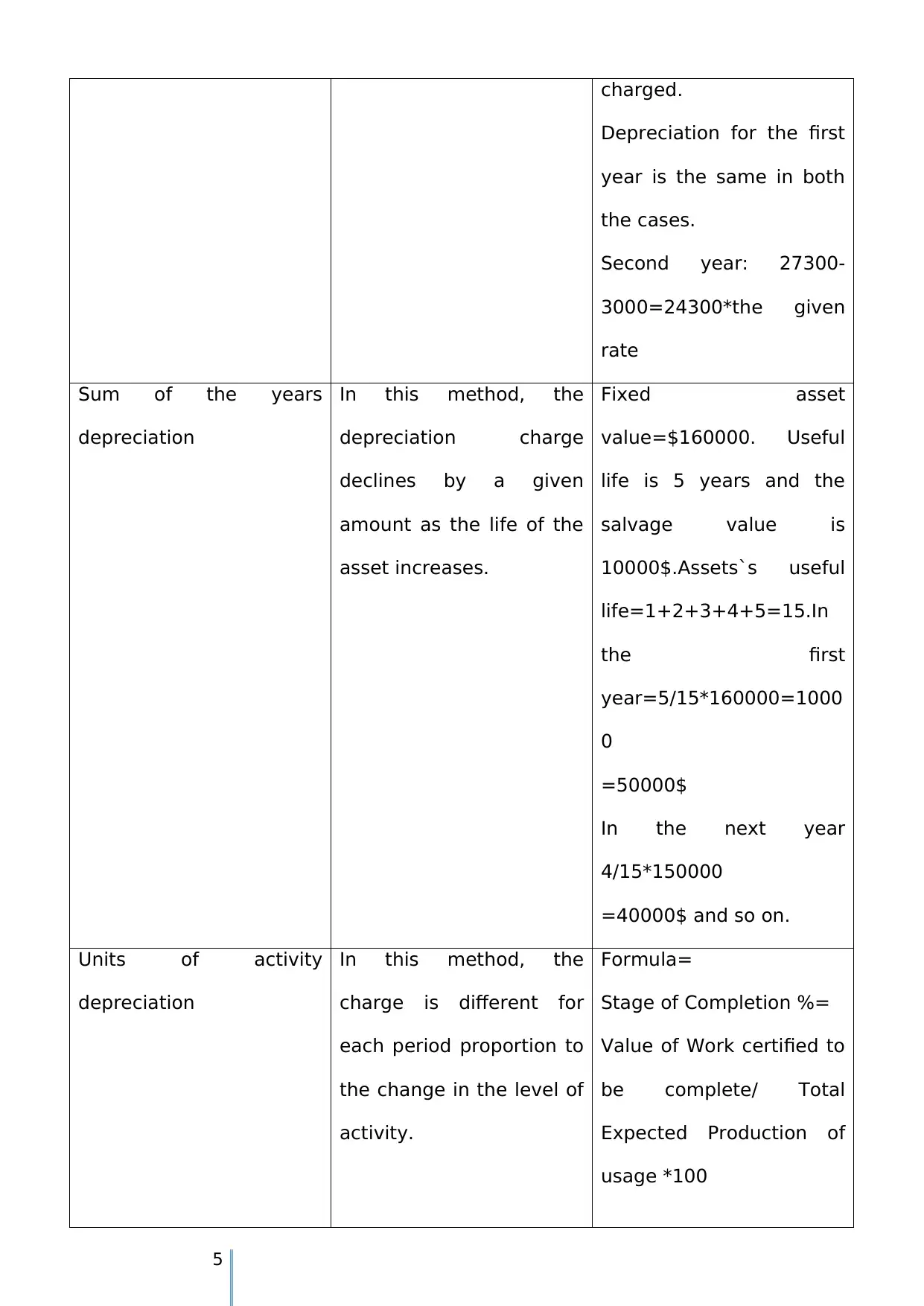
charged.
Depreciation for the first
year is the same in both
the cases.
Second year: 27300-
3000=24300*the given
rate
Sum of the years
depreciation
In this method, the
depreciation charge
declines by a given
amount as the life of the
asset increases.
Fixed asset
value=$160000. Useful
life is 5 years and the
salvage value is
10000$.Assets`s useful
life=1+2+3+4+5=15.In
the first
year=5/15*160000=1000
0
=50000$
In the next year
4/15*150000
=40000$ and so on.
Units of activity
depreciation
In this method, the
charge is different for
each period proportion to
the change in the level of
activity.
Formula=
Stage of Completion %=
Value of Work certified to
be complete/ Total
Expected Production of
usage *100
5
Depreciation for the first
year is the same in both
the cases.
Second year: 27300-
3000=24300*the given
rate
Sum of the years
depreciation
In this method, the
depreciation charge
declines by a given
amount as the life of the
asset increases.
Fixed asset
value=$160000. Useful
life is 5 years and the
salvage value is
10000$.Assets`s useful
life=1+2+3+4+5=15.In
the first
year=5/15*160000=1000
0
=50000$
In the next year
4/15*150000
=40000$ and so on.
Units of activity
depreciation
In this method, the
charge is different for
each period proportion to
the change in the level of
activity.
Formula=
Stage of Completion %=
Value of Work certified to
be complete/ Total
Expected Production of
usage *100
5
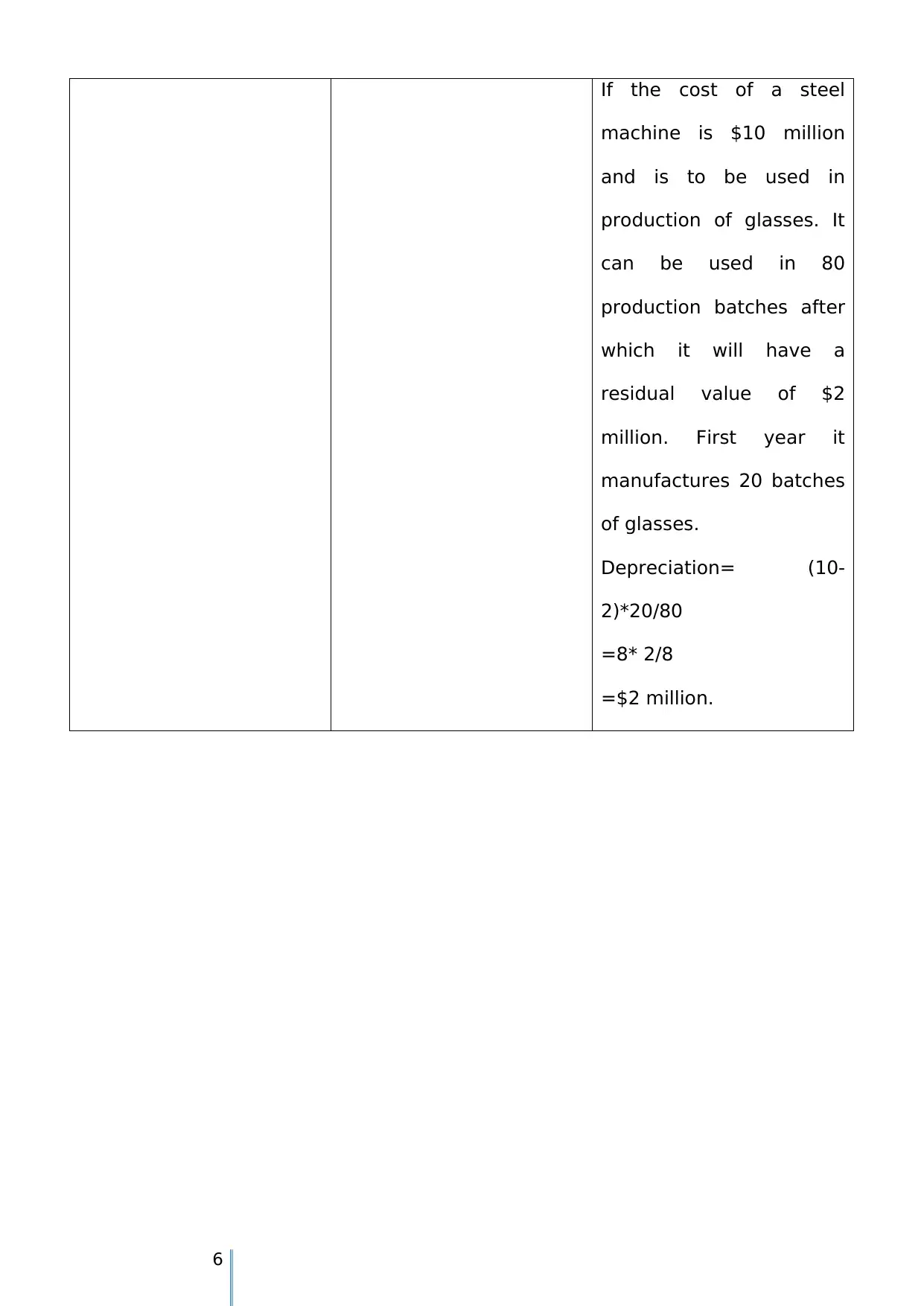
If the cost of a steel
machine is $10 million
and is to be used in
production of glasses. It
can be used in 80
production batches after
which it will have a
residual value of $2
million. First year it
manufactures 20 batches
of glasses.
Depreciation= (10-
2)*20/80
=8* 2/8
=$2 million.
6
machine is $10 million
and is to be used in
production of glasses. It
can be used in 80
production batches after
which it will have a
residual value of $2
million. First year it
manufactures 20 batches
of glasses.
Depreciation= (10-
2)*20/80
=8* 2/8
=$2 million.
6
⊘ This is a preview!⊘
Do you want full access?
Subscribe today to unlock all pages.

Trusted by 1+ million students worldwide
1 out of 6
Related Documents
Your All-in-One AI-Powered Toolkit for Academic Success.
+13062052269
info@desklib.com
Available 24*7 on WhatsApp / Email
![[object Object]](/_next/static/media/star-bottom.7253800d.svg)
Unlock your academic potential
Copyright © 2020–2025 A2Z Services. All Rights Reserved. Developed and managed by ZUCOL.




